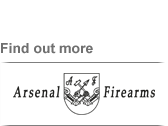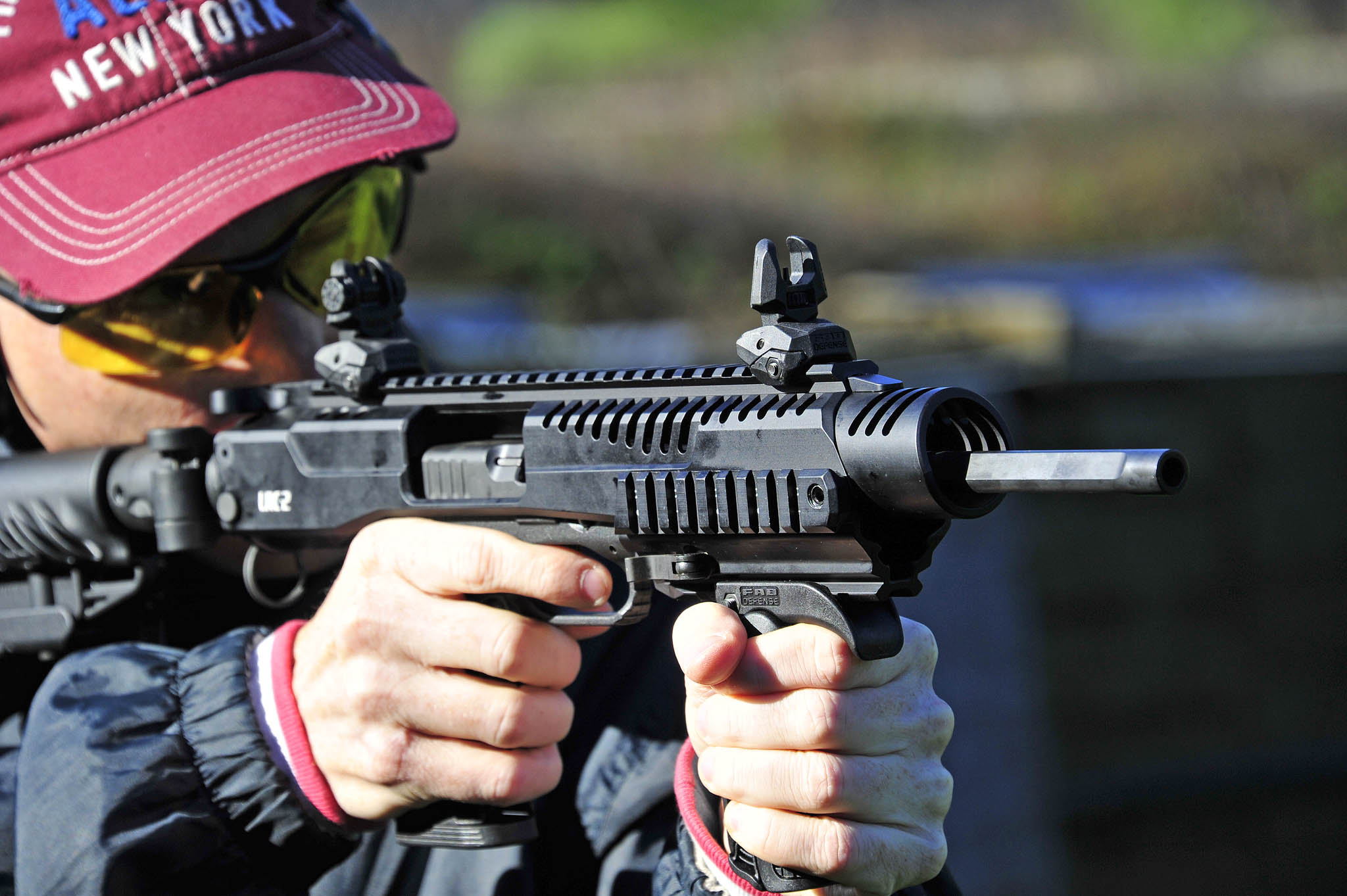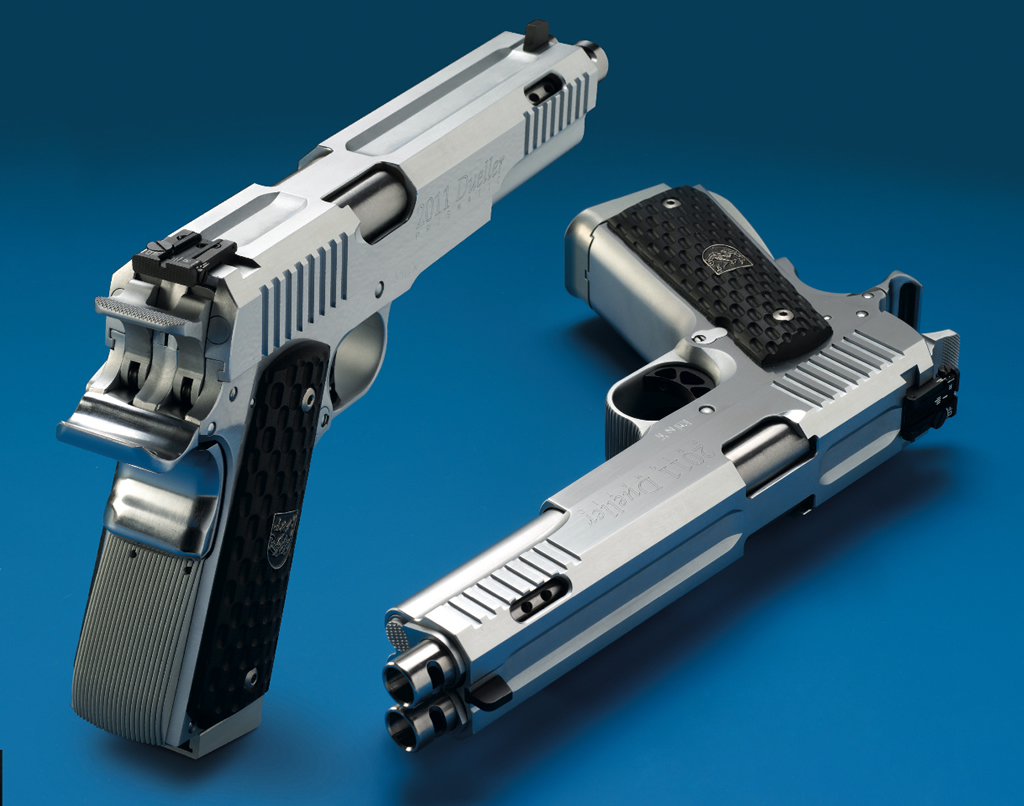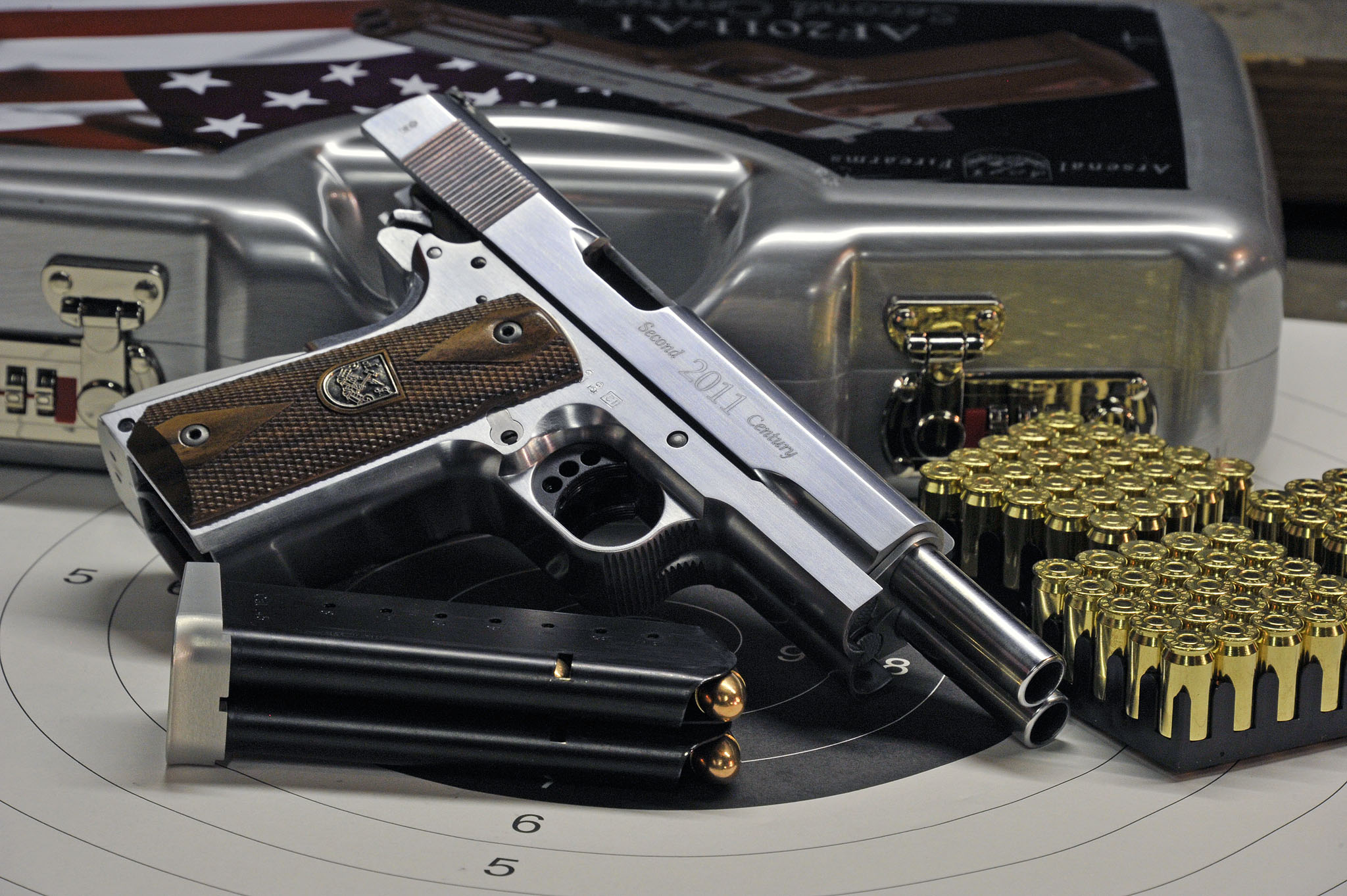Article also available in other languages

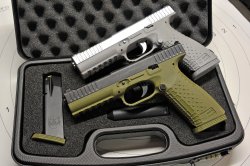
It has been the pivoting point of the Internet buzz for two years now, and shooters and gun enthusiasts may be a little bit tired of waiting, but the wait is almost over: unless any major factor gets in the way, the Arsenal Firearms AF-1 Strike One semi-automatic pistol, first officially showcased at the 2012 IWA expo in Nuremberg (Germany) and much admired at the 2013 editions of both the SHOT Show and IWA itself, will hit gun stores by the end of September in Italy – the first Country to have it.
Never minding the buzz − mostly spread all through the Internet by unexperienced, often unqualified persons − even just for a second, the question is: what is really a Strike One, and is it really such a great leap forward? Observers and enthusiasts worldwide have been soliciting an independent test for the Strike One ever since it was first showcased, and now here we are: ALL4SHOOTERS.COM is the first entity – and will remain the first for quite a while! – to have been cleared to perform an independent test-fire of the gun.
Sure, somebody may argue that we're not “really that independent” after all... we've been writing enthusiastically about the Strike One ever since it was first seen. We know the score: there's a lot of people around who like to open their mouths just because they don't know... or they can't... or because they're just envious. We've been in this business for a while now, and we know what we talk, and write, about. That's why we believe in the Strike One project. Unlike many so-called “experts” on the Web, we immediately understood that this is not “just another striker-fired polymer pistol”, but a true ensemble of original features, seldom – if ever – seen before on a large-scale production sidearm. So, let's start from the beginning.
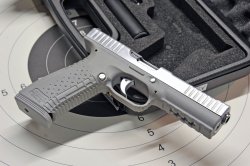
The Arsenal Firearms Group of Companies (no relations with the Bulgarian ARSENAL JSCo. company, a manufacturer of AK-style rifles, nor with its US-based subsidiary, ARSENAL Inc.) was founded about three years ago by Mr. Nicola Bandini − one of Italy's most important gun experts and gunwriters − and Mr. Dimitry Streshinsky, a Russian citizen known for the masterpieces of his Miniature Arsenal out of Saint Petersburg.
As of today, the Arsenal Firearms company manages a main production plant in the northern-Italian town of Gardone Val Trompia – the heartland of the Italian gun industry – and a Russian factory, located in Moscow, where a version of the AF-1 Strike One known as the “Strizh” will be manufactured for the local military and law enforcement.
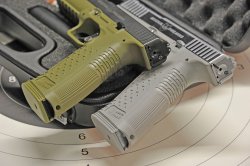
The activities at Arsenal Firearms have been aimed to research and development for innovative solutions since the very beginning, and that's one of the reasons why, despite many anticipations, the distribution of the Arsenal Firearms AF-1 Strike One pistol hasn't started yet. As a matter of fact, the company decided not to start hastily and get caught with their pants down later, either from the quantity or quality standpoint. The “Strike One” has been causing so much hype, in the past months, that the Arsenal Firearms company decided that it would have been better to prevent any slightest chance for the product to have any intrinsic drawback or issue by simply extending the final prototype research stage; on the other hand, given the enormous volume of pre-orders placed by distributors worldwide versus the ever-increasing market demand for this kind of firearms – especially from the USA – Arsenal Firearms took its time to stock up a good quantity of ready-to-ship pistols and enough material and technologies to quickly manufacture an even larger number of them should the need arise. This might seem somewhat a propaganda uproar, but we visited the Arsenal Firearms plant, and we could see this all with our own eyes!
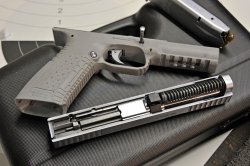
Taking a look at the AF-1 Strike One, the first concept that came to our minds is “evolution”. As stated before, the Strike One was conceived to surclass virtually all other existing service, defensive and sporting pistols, and it has full potential to. An untrained eye may see it as “yet another polymer pistol”, as the parts that make up for its cosmethic appearance may look standard at a first glance; but that's what they may look like. What they are, is a whole another matter.
The Arsenal Firearms AF-1 Strike One semi-automatic pistol employs a steel slide, fully machined from a solid billet of “#36 steel”, a proprietary stainless steel alloy whose main physical and chemical composition features are a well-kept industrial secret. The steel is provided by a well-established 100% Italian foundry in long bars, which are cut to lenght at the Arsenal Firearms factory to form the solid billets; said billets are afterwards loaded in pellets into a Swiss-made, five-axis CNC machine that's one of the most technologically advanced pieces of machinery available to the Italian gun industry as a whole today. The machine will work an almost complete slide – lacking the finish and small parts, of course – out of a solid billet in around 90 seconds, and it can be pre-programmed and controlled by remote, as a matter of fact requiring no direct surveillance to operate. The Arsenal Firearms company is thus able to manufacture the slides for the AF-1 Strike One pistol even when its lines are closed for the weekend!
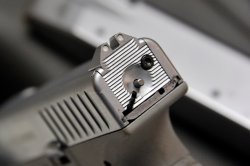
The frames are instead manufactured out of what the company calls a “super-polymer”. Yet another industrial secret, the “super-polymer” is a synthetic compound of polymers, added with fibreglass, carbon-fibers and elastomers that will provide it with a superior resistance against adverse environmental conditions. These frames, ergonomically molded and featuring a MIL-STD-1913 rail for tactical accessories, feature three times the technology – and cost three times more to manufacture! – than Glock frames, but are also three times stronger and performant, as demonstrated by extremely rigorous mil-spec tests it's been submitted to by government entities in Russia in the wake of a possible large-scale adoption of the locally-manufactured samples by the Russian Armed Forces and Police. These polymer frames also feature inner metal guides for the slide, manufactured through MIM (Metal Injection Molding) and further refinished to improve strenght and quality.
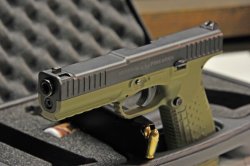
Alternatively, the Arsenal Firearms company will also provide the AF-1 Strike One with aluminium frames, obtained through a burr removal process and a subsequent EDM (Electro-Discharge Machining) procedure out of a solid billet of ERGAL-55 aluminium alloy, also known outside of Europe as 7075-T6 – the same alloy commonly used for the manufacture of lower receivers for AR-15 rifles and carbines. The aluminium alloy adds overall weight to the gun, and makes it more apt for IPSC competitions, where shooters generally like their guns heavier.
Barrels are cold-hammer forged out of full bars of 36-NCD4 stainless steel, and feature a standard rifling, with six right-handed grooves and a 1:10 pitch. All pins are fully machined from stainless steel as well, and so are some of the smallest parts, such as the triggers, while others – that's the case for the springs, the slide stop levers and ambidextrous magazine release catches – are manufactured through MIM. The standard iron sights, mounted on the slide through machined cuts, feature white inlay dots for quick alignment.
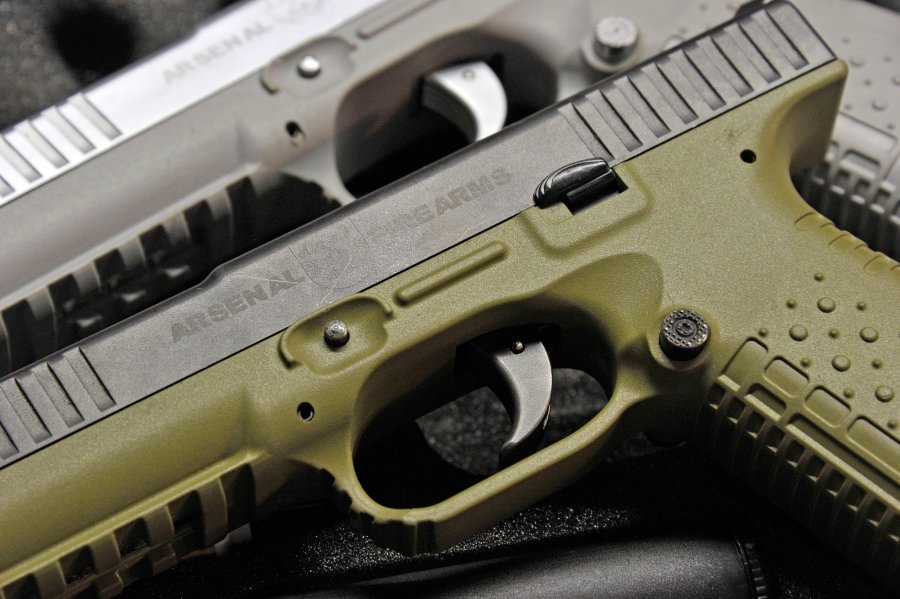
Magazines are available only in a full steel variant, with polymer follower, MIM spring and polymer pad. Standard capacity is of eighteen rounds in 9mm – and that's the only caliber the Strike One will be available in, as of now. Variants in .40 Smith & Wesson and .357 SIG should be launched in the near future, while a .45 ACP variant is in the works.
The main feature of the Strike One magazine is the use of integral feeding ramps, Colt 1911-style (mind, we're talking about the early 1911, not 1911-A1 and following). This ensures utter reliability in the feeding procedure, no matter the position from which the gun is fired: it may be inclined at any angle, or even upside down, it will feed and cycle flawlessly.
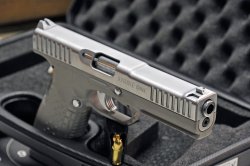
And it gets better when it comes to other features, such as the transfer bar.
The Arsenal Firearms AF-1 Strike One features a totally original trigger, without any manual safety of sort, which the inventor, Nicola Bandini, calls a “Rotating-sliding” trigger. It may be described as a two-stage trigger with the transfer bar divided in two parts. The first part consists in a fully machined, polished and hard-chromed pivot which is specifically conceived and manufactured to allow no imperfection that may result in a “roughness” of any sort when the trigger is pulled. Its function is to disengage the internal safety and the trigger stop, and to engage the second part of the trigger bar, which is manufactured through metal injection molding and will release the striker – which, in turn, is fully internal and only slightly protrudes from the rear side of the slide in the form of a small, round colored bump, much in the style of Walther P99 or Caracal pistols, to act as a tactile and visual loaded chamber indicator.
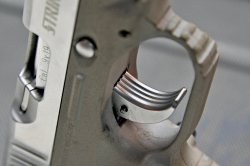
The locking piece, obtained through MIM, is however the true heart of the system, and the true masterpiece of gun engineering around which the Arsenal Firearms AF-1 Strike One has been conceived. Technically speaking, the AF-1 Strike One is a short-recoil operated semi-automatic pistol, with a locking piece that features four locking lugs and is much akin to the kind of “Box Lock” you'll normally see on an Express or Drilling rifle, or on a double-barrel shotgun. The locking piece is unlocked when the gun is fired through the extremely short barrel recoul, and slides vertically through a machined steel pin and an inclined milled guide, which allows for a calculated movement with no true rear travel end, or travel stop.
Furthermore, the barrel of the AF-1 Strike One is secured to the frame by a locking lug and a pin; the locking lug is designed so that it will allow only one degree of movement freedom to the barrel itself when the gun is fired; it will not tilt upwards in any way, and will only recoil slightly – that's berely four millimetres – following the rearwards travel of the slide as the gun cycles. Bore axis is also very low, as the distance between the bore and the grip is merely twelve millimetres.
As a result, muzzle climb is extremely limited, with an angle of merely ten degrees, and the gun will remain extremely stable and will cycle incredibly fast, in merely 0.045 milliseconds. This will all turn in a potentially extreme rate of fire: despite being semi-automatic only in nature, the AF-1 Strike One can be fired to fast that a well-trained shooter and IPSC champion called in to test the potential ROF of the pistol has been able to shoot up to 800 rounds in a minute.
This greatly outperforms any other service, defensive or military-issue pistol on the market, and gives the edge to competitive shooters in IPSC and other rapid-fire sports-shooting specialties.
Anyone with at least the slightest idea of how a gun is really built will now be fully aware of the fact that the Arsenal Firearms AF-1 Strike One is not a copy, a clone or a knock-off or NO PISTOL WHATSOEVER on the market, and it's definitely NOT a Glock knock-off, as Glocks are basically striker-fired Browning designs with a lightened double-action trigger. And all this, comes at a manufacturer's suggested retail price in Europe shouldn't exceed 700€ - while a price for foreign markets hasn't been announced yet, more specifically none has been established so far for the American market as the BATFE is yet to clear the Strike One for import in the U.S.
This said, let's take a look at how it performs at the range.
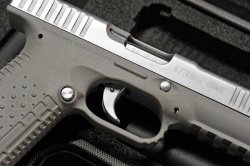
We had handled Arsenal Firearms’ Strike One semiautomatic service and defense pistol a few times before in the past, during international trade shows such as the SHOT Show and the IWA. In those occasions, we already had the chance to closely check it out and somewhat "play" with it, with all the limitations that trade shows usually entail; including the fact that, although supposed to be fully working guns with only the firing pin removed, the firearms we saw and toyed with were late-stage prototypes at best.
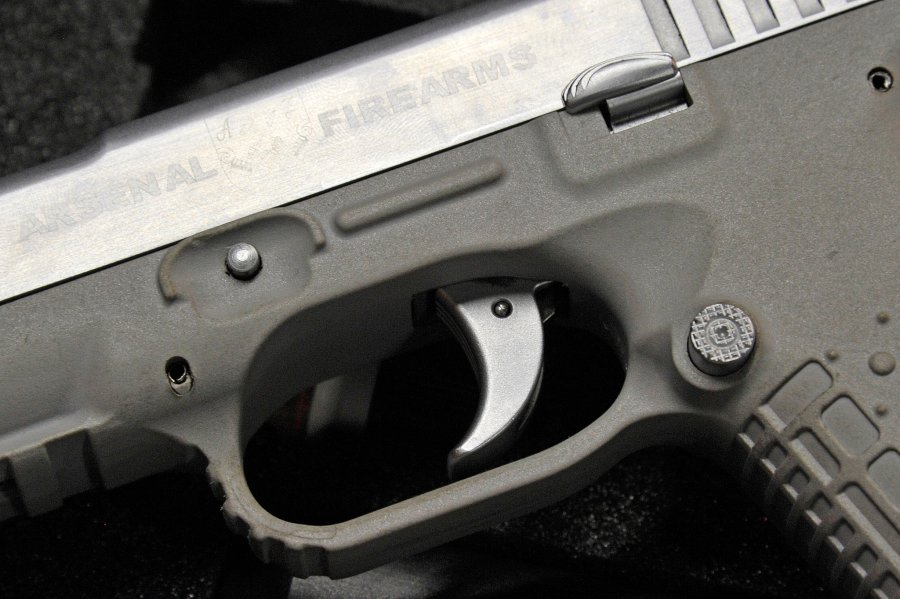
Today, at a 25 meter private indoor shooting range, Arsenal Firearms provided us with two 9mm Strike One final pre-production sample handguns to live fire test, with an almost unlimited supply of 124 grain FMJ ammunition, lots of targets and all the time we would need. These two Strike One pistols are the first guns ever to be live fire tested officially by any member of the media, and we, as ALL4SHOOTERS.COM, are honored to be the ones to proudly and independently report to our readers the first full review of these interesting guns.
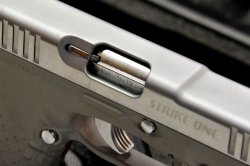
As we already mentioned, we did see deactivated prototypes of the Strike One pistol before, and our first impressions did not change handling the actual live gun. The firearm’s design has not changed if not in very subtle details, it is very large in appearance, and the sort of “hunchbacked” squarish and boxy slide is quite peculiar and visually stands out, making the pistol immediately recognizable.
The slide features a cleverly cut, 45° angled and specially profiled ejection port, ensuring ample clearance to reliably expel the spent case and providing a very strong cross section at port due to the actually smaller open area compared to other designs; large and very grippable serrations are cut on both the rear and the front sides of the slide to provide a positive hold chambering a round or performing immediate action routines.
The rear of the firing pin, when armed, protrudes from the back of the all-steel rear slide cover plate, that also doubles as the base for the rear sight, being machined in a single piece.
The polymer frame is quite elaborate and offers a reliable and reassuring grip, thanks to the handle featuring an intricate “3D” grip pattern, with a flared mag well to improve magazine reload. The trigger guard is wide and rounded, and the ambidextrous magazine release button is easily accessed, as is the slide stop hold open lever.
Grasping the slide to pull it back requires little effort, and the slide travel is very smooth. Because of the innovative, falling locking piece design of the Strike One, its slide is quite “fat”, being wider than most competitive semiautomatic pistols using a modification of the Browning/Petter design, and on the other hand, it is also thinner; which means, the web of the hand is higher up and closer to the line of the bore than any other large caliber, semiautomatic service/duty handgun.
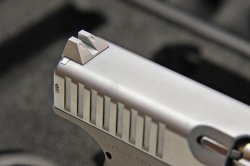
Familiarizing ourselves with the Strike One before the live fire tests, working the slide, testing the magazine release and performing mag changes, dry firing to get a feel of the trigger, and trying different stances and holds with it, we noted the perfect angle of the handle, and the incredibly natural way the firearm lines up to the target as soon as we bring it up to aim. The index finger, during a simulated fast draw, if not placed inside the trigger guard and left along the slide, lines up to the target in a surprisingly accurate way. More so than with any other gun we tested. So, we actually did something that should never be attempted, shooting with our eyes closed. More on this later.
Loading the magazine, which is a top notch quality part manufactured by Mec-Gar in Italy, is easy, only the last two rounds of the 17 that the mag holds are slightly harder to slide in. The mag slides in the gun effortlessly and locks positively into place; the slide snaps closed on a loaded magazine and we’re ready to fire our first round.
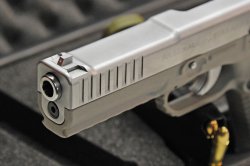
The fixed sights line up easily and feature white painted dots; the sight picture is accurate and we quite liked them. As the rear sight is a single piece with the rear slide cover plate, it is non-adjustable, so all adjustment is performed on the front dovetailed sight, which provides a very wide range of adjustment. We favor this arrangement as it keeps the rear notch always perfectly centered with the slide.
Squeezing the trigger is a pleasure, we’re reminded of a very good quality double action revolver with a roll-over trigger travel: smooth all the way, release is almost unpredictable and overtravel is negligible. Reset is almost instantaneous after pressure is released over the trigger, and the automatic single-arc trigger safety, involving a specific geometry and travel pattern of the trigger itself, never gets in the way and is actually not consciously perceivable during shooting.
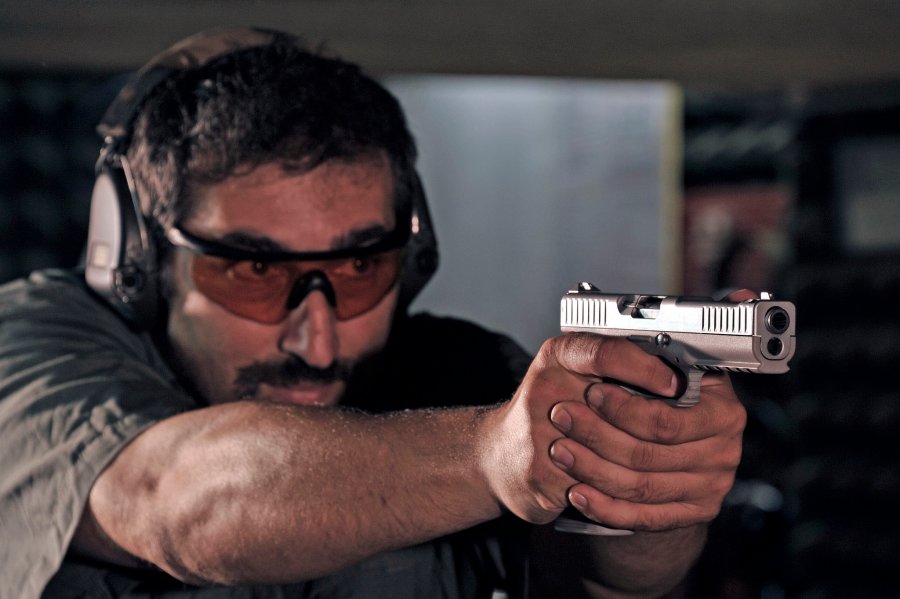
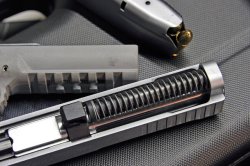
In a previous dry fire test, with an early pre-production mechanical sample and hard-chromed display gun, we experienced a slightly inferior trigger, with a bit of creep to an otherwise decent pull; the pre-production guns tested today, a much closer match to the actual production and commercially distributed pistols with a higher SN, featured flawless operation.
After a magazine worth of rounds, we got used to the peculiar trigger and its perceived lighter than average pull – due to the wide trigger surface - and started producing tighter and tighter groups, the Strike One displaying an excellent accuracy; at 10 and 15 meters our ten-round groups printed less than four and five centimeters (that’s a couple of inches at 11 and 16,4 feet respectively) using a modern double handed stance and hold, with slow fire – a round every second or so.
We’re sure that a better shooter than ourselves undoubtedly would manage to exploit the huge potential of the gun, with much tighter groups.
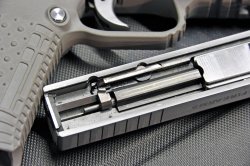
Our hand wraps comfortably around the handgun’s grip, and every one of the few controls the gun has – trigger, slide stop hold open lever, fully ambidextrous and patented magazine release – are ergonomically and conveniently placed to be very easy to reach when needed and out of the way when they are not.
Recoil is mild, never sharp, and muzzle flip is extremely controllable; recovering aim and finding back the target is immediate. In our test (it is obvious in the videos), our hold is never strained, the gun is held firmly but in a relaxed manner, allowing the gun to recoil. No malfunction whatsoever, not even purposely holding the gun with only one hand and just enough strength to safely shoot it. We admit trying to have it short cycle and reproduce a FTE, we could not safely make it do so!
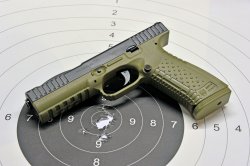
Speed drills are a charm, swapping a magazine is really fast and the slide release lever is quite well placed, the flared magazine well almost feels like using an IPSC ready gun, guiding the loaded mag home in a much better way than most any other duty handgun we’ve tested up to now. Rounds are indeed released as fast as anyone can squeeze the trigger; theoretical RPM is slightly above 1300, meaning more than twenty rounds are shot per second, thanks to an extremely fast lock time and slide travel. With the help of a certified range instructor, to check and control our movements and insure safety, we tested the gun shooting two rounds blinded, pointing the gun in the direction of the target with our eyes closed. The results are surprising, our first test placed two rounds perfectly level with center of mass but slightly left in an 8 cm group at 7 meters, and encouraged by this result, we subsequently actually managed to place five rounds on the target, in a group of 22 cm! An unconventional experiment to confirm the handgun’s excellent ergonomic design and engineering, which actually makes it feel as it was an extension of our body.
In conclusion, our opinion of Arsenal Firearm’s Strike One semiautomatic pistol is absolutely positive, and a great experience shooting it to boot. Design wise, the pistol has strong character and “means business”, ergonomically sound, and well balanced; standard operative routines are intuitively carried out as if we had always been using the gun, and live fire feedback in terms of recoil and muzzle flip are great, especially in regards to line of aim and target sight recovery during quick string fire. Our only gripe with it would be the sheer size of the gun, which is larger and wider than most 9mm semiautos, also due to the full 5” length of the cold hammered barrel, and will undoubtedly limit concealed carry – a moot point for duty and overt holster carry, and, besides, surely a ‘Compact’ version is in the works…
TECHNICAL SPECS
Manufacturer | Arsenal Firearms S.r.l - Via X Giornate 14 25063 Magno di Gardone Val Trompia (BS) – Italy |
Model name | AF-1 Strike One |
Gun type | Semi-automatic pistol |
| Caliber | 9x19mm "Parabellum", 9x21mm IMI - .40 Smith & Wesson and .357 SIG planned for the near future |
Working system | Locked breech, recoil operated with four-lugs sliding locking piece |
Barrel | 128mm, 6 grooves RH, 1 pitch in 1:12, one degree of freedom |
Capacity | 17+1 rounds in double-stack, staggered magazine |
Trigger | Automatic safety, Single-Action only |
Safeties | Single arc trigger safety, with firing pin automatic safety |
Sights | Interchangeable back plate/sight, fixed or adjustable, or Micro-Dot ready |
Manufacturing materials | Stainless steel barrel and slide, polymer or ERGAL aluminium alloy frame |
Total length | 210mm |
| Total height and width | 143mm (height) - 33mm (width) |
Weight (empty) | 750 g. (polymer frame) - 890 g. (alloy frame) |



